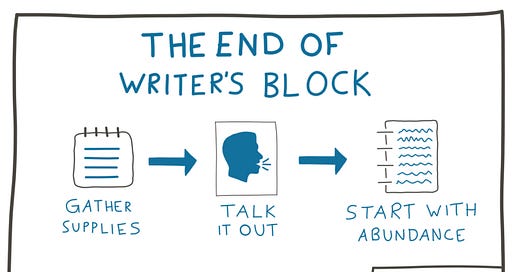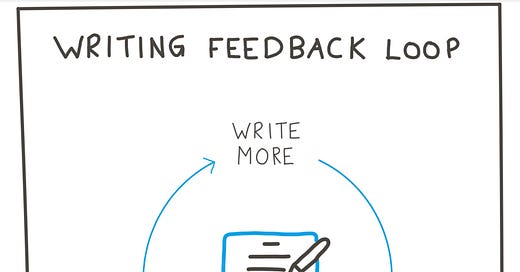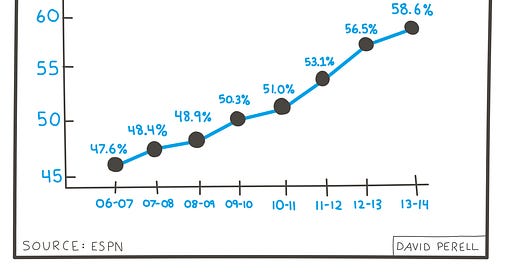

Discover more from Monday Musings by David Perell
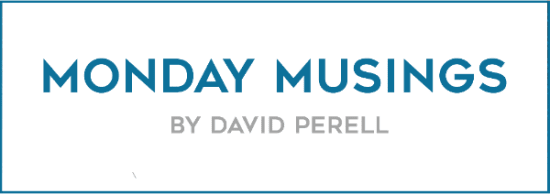
Hey everybody,
I have two updates for you.
Workshop: I’ll be hosting a workshop in New York City on July 1st. In it, I’ll share my process for creating as consistently as I do. The workshop will be fun, dynamic, and hands-on. You'll leave with a fresh approach for writing and a system for cultivating creativity on-demand. I hope you’ll join us.
Summer of Learning: I’ll also be teaching two courses this summer: Building a Second Brain and Write of Passage. We’re combing the courses into a bundle called The Summer of Learning. When my friends look at my writing and note-taking system, they always say the same thing: “You have a superpower.” Good news. There are no secrets. I’m going to share all my tactics with you. By the end of the summer, you will have the superpower too. You’ll be able to retain more of what you read, spark creative ideas on-demand, and accelerate your career by writing online. Expect more details next week.
The Go-For-It-Window
Technology advances faster than social norms. Large gaps between accelerating technologies and stagnating social norms create lucrative opportunities. But these opportunities are only available for a limited time. In that moment, people can capitalize on the difference between the real and perceived state of the world. I call this sliver of opportunity the “Go-For-It-Window.”
You know you’ve found the Go-For-It Window when you’re simultaneously woke and confused; when you’re shocked your idea doesn’t already exist; when you know something nobody else does; and when it seems like others see the world in black and white, while you see the world with vibrant, technicolor glasses.
Opportunity and popularity are inversely correlated. Sometimes, the paths that look safe are the riskiest, and vice versa. If you’re looking for an under-exploited opportunity, you’ll have to go against the herd. Thus, I frame the Go-For-It Window with a quote from investor Jim Grant: “Successful investing is about having people agree with you… later.”
As a general rule, people are blind to opportunities in the Go-For-It Window. But in retrospect, they seem blindingly obvious. To remove the blinders, you have to escape the myopia of social norms. As Alex Danco said in my interview with him: “Investors arbitrage the state of the world today — before they get started — with the state of the world after they’re done disrupting it.”
Good news. You don’t need any secret knowledge to discover ideas in the Go-For-It Window. But you will need a blend of James Bond confidence and a willingness to ignore the taunts of the crowd. Otherwise, you’ll drown in the sweat of criticism.
To illustrate how the Go-For-It window shows up in real life, I’ll draw on four examples: two from the past, two from the present. I’ll take each in turn.
Past Examples of the Go-For-It-Window:
Airbnb: When I first started using Airbnb, half of my friends thought I was insane. Renting a stranger’s home was reserved for hippie couch surfers who were running away from their childhood. Airbnb didn’t just extend the frontier of technology. It pioneered a new social norm. By matching latent demand with under-utilized supply, Airbnb’s founders commoditized trust, changed the way we travel, and capitalized on the Go-For-It-Window.
NBA Three-Pointer: The NBA introduced the three-pointer in the 1979-80 season. Social norms, not math, halted adoption. At first, people thought the three-point shot was a cheesy gimmick. In the first season after it was introduced, making 21 three-pointers in a season was strong enough to rank in the top 20. But in 2016, Stephen Curry made 13 three-pointers in a single game. The three-pointer was introduced almost four decades ago. And yet, the truth still defies intuition. Since most NBA teams still don’t shoot as many three-pointers as they mathematically should, the Go-for-It Window is still open.
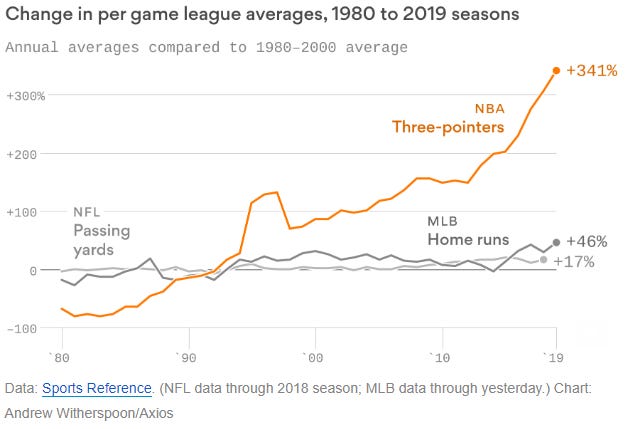
Current Examples:
Skip the graduate degree: Too many kids go to graduate school. But graduate school isn’t as necessary as it once was. People can build their own credentials now. They can start a project, write online, or record YouTube videos. This year, thousands of MBA graduates will enter the workforce with more than $100,000 in student debt. Graduate school isn’t just expensive. It’s time-consuming too. If you want to demonstrate value to a future employer, there are cheaper and faster alternatives to graduate school. For example, starting a successful blog is a simple way to build your credentials. Employers know that a strong personal blog signals intelligence and curiosity, so when they find a writer they admire, they sometimes try to hire them. Kids know this. Parents don’t. Thus, the-Go-For-It-Window is open for people who want to start writing online.
Homeschooling: In the next decade, somebody will build a billion-dollar business for homeschooling. The Go-For-It Window is wider than the Grand Canyon. People can teach themselves now. The bottleneck to learning is curiosity, not access to information. As the famous line in Good Will Hunting goes: “You wasted $150,000 on an education you coulda got for $1.50 in late fees at the public library.” Most public schools are suboptimal. And private schools are walk-right-out-the-door-expensive. A study by the National Center for Education Statistics found that 20 percent of college graduates didn’t have basic quantitative math skills. Only one-third of college graduates could read a complex book and comprehend what they were reading. Homeschooling startups will match students with parents and teachers. Together, communities of parents will hire teachers and pool resources for toys, books, and computers. As it stands, the logistics are easy compared to the societal challenges. People don’t like taking risks with their children. Will society look down upon children who are homeschooled? Will homeschooling harm college acceptance rates? Or will the university landscape change as well?
The Go-For-It-Window is the hanging curve ball in the middle of the plate. It’s the right opportunity at the right time.
Opportunities in the Go-For-It-Window close fast. They’re fleeting. When you sense an opportunity, act on it. Research the idea, speak with industry experts, and outline a solution.
No matter who you are, where you work, or what you’re interested in, there are hidden opportunities in front of you. If you’re blinded by outdated social norms, you’ll miss opportunities in the Go-For-It Window.
— —
Quick note: I am in the Go-For-It Window with an exciting, writing-related idea. If you know any designers, software engineers, or product managers who have a strong personal blog, please send them my way. I’d love to speak with them.
Fresh Ideas
Personal Marketing
I wrote a very short post about Personal Marketing. The internet is the best matching tool ever invented and the benefits go to people with an online presence. It was inspired by a quote by Marc Andreessen:
“The world is busy. There are 7 billion people on planet earth whose time is already fully allocated. The work has to speak for itself, but somebody has to pick up the flag and carry it into the world. None of this is an excuse for having the work not be good.”
You can read the full post here.
Coolest Things I Learned This Week
Moscow Train Stations are Beautiful



Understanding Complex Writers
Pro tip: If there’s an influential thinker whose writing you don’t understand, find their interviews.
Two examples:
Marshall McLuhan
René Girard
They were brilliant thinkers, but terrible writers. And yet, their interviews are crystal clear.
McLuhan and Girard are easy to summarize, but hard to truly understand. You must grasp their ideas intellectually *and* emotionally. Instead of giving you knowledge, they change your perception.
McLuhan and Girard are hard to understand because their theories are too simple. Their writing is so foundational and so universal that we simultaneously dismiss them as trivial *and* too multi-dimensional. Thus... like fish in water, we’re blind to the weight of their words.
If you’d like to learn about McLuhan or Girard, I have two links for you:
The Moon Landing
In 1999, as the century was ending, the historian Arthur Schlesinger Jr. was among a group of people who was asked to name the most significant human achievement of the 20th century.
In ranking the events, Schlesinger said, “I put DNA and penicillin and the computer and the microchip in the first ten because they’ve transformed civilization.” But in 500 years, if the United States of America still exists, most of its history will have faded to invisibility. “Pearl Harbor will be as remote as the War of the Roses,” said Schlesinger. “The one thing for which this century will be remembered 500 years from now was: This was the century when we began the exploration of space.”
He picked the first Moon landing, Apollo 11, as the most significant event of the 20th century.
Car Production During World War II
With the exception of Jeeps, the American car industry just *stopped* producing consumer cars during the war.

Paintings by Swiss Painter Alexandre Calame



The Limits of Data
From Bob Lefsetz:
“Yoplait went back to the drawing board once again. Named its new product “Oui,” which some recalled as a porn magazine of yore, which is true! And the more negative feedback the company got, the more they knew they were on the right track. Data will tell you where you’ve been, but not where you’re going.”
From Rory Sutherland:
"There’s a brilliant TEDx Cambridge speech from an anthropologist who discovered that Nokia’s idea that nobody would buy smartphones from the developing world because they were too expensive. An anthropologist went in to Nokia and said 'I’ve been doing work in China in refugee camps. When a smartphone because available, even if it’s just an iPhone knockoff, people will sacrifice half their disposable income to own one.'
So remember, all big data comes from one place: the past. And all the data they had — 500,000 data points — were all based on what people would pay for a feature phone. One they changed the context to the smartphone, the rules changed. The anthropologist only had 150 data points. Nokia had 500,000. And Nokia’s data said that Nokia should hold off launching smartphones for three years. They won the argument because they had more data.”
Madagascar’s Baobab Trees Are Straight Out of a Fairy Tale



Photo of the Week


Over the weekend, I visited the New York Transit Museum. The most surprising thing was that all of New York’s subway infrastructure had been laid down by 1950. Since World War II, there have been almost no new additions to the New York subway. A new bridge hasn’t been built since 1964. When building anything, from a city, to a company, to an organization, you should give extra attention to the foundation. Once it’s laid, it’s hard to change.
If you’re ever in New York, I recommend a visit to the museum. It’s located underground in an old Brooklyn subway station. When you’re there, explore the maps section, walk through the old train cars, and look for opportunities in the Go-For-It Window.
Until next week,
David Perell
Subscribe to Monday Musings by David Perell
A Celebration of Learning and Curiosity. Written by David Perell



